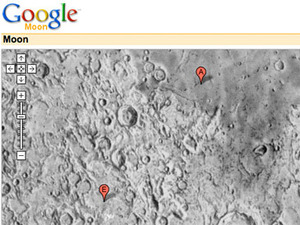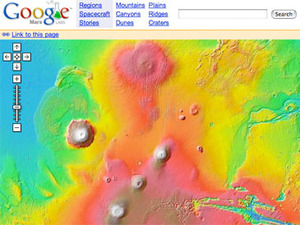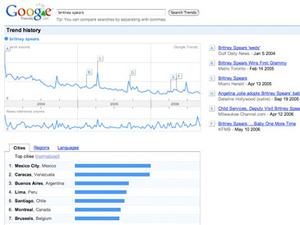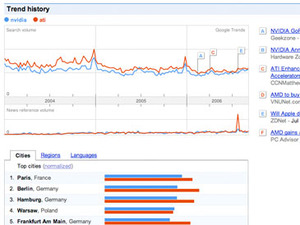
Google Moon and Google Mars:
Whilst the world is still trying to get their heads round the scale of Google Maps and its desktop client counterpart, Google Earth, the company has expanded its satellite photography fieldtrip into outer space and come up with Google Mars and Google Moon. These apps, you guessed it, use the Google Maps interface to allow users to view the two stellar bodies in all their mapped photographic glory. In addition to the usual features such as zooming, panning and permalinking (creating hyperlinks to current map views), the spaced out versions also include Elevation, Visible and Infrared views, which show the maps shaded and colour-coded by altitude, as a mosaic of standard visible images and from a perspective of the infrared group in the spectrum.
Although at face value the maps are fairly dull, there are an abundance of preset links to help guide you to spacecraft landings, place names and regions of special significance (in case you ever plan to visit them). All in all, Google Mars and Google Moon are a great continuation of the successful Google Maps application, and it shouldn’t be too long before Google has an interplanetary route planner up and running (I’m thinking ‘Google Redshift’?)


Google Trends:
Google Trends is a basic yet incredibly useful tool which allows users to search for different search terms and find out which cities, regions and languages they were most searched for in. As well as this, it also uses a graph to show how search queries changed over a period of time, as well as allowing you to specify a certain country and/or month or year to show a graph for. As trivial as this initially sounds, Google Trends is potentially a great market research tool, as it shows fluctuations in the public’s interest in certain topics over periods of time, and would ultimately be useful for tracking demand for certain items.

 For example, a small consumer electronics chain could enter a search for LCD monitors, find out which regions in their own country are searching the internet for them the most, then be able to distribute stock accordingly. Of course, results should be taken with a pinch of salt but it’s easy to see what Google was thinking when it made Google Trends. Another handy feature is that Google Trends cross-references search queries to its Google News database and pinpoints different news events on the graph for you, allowing the user to find out how stories in the media have affected interest for that topic.
For example, a small consumer electronics chain could enter a search for LCD monitors, find out which regions in their own country are searching the internet for them the most, then be able to distribute stock accordingly. Of course, results should be taken with a pinch of salt but it’s easy to see what Google was thinking when it made Google Trends. Another handy feature is that Google Trends cross-references search queries to its Google News database and pinpoints different news events on the graph for you, allowing the user to find out how stories in the media have affected interest for that topic.
Although like all other Google Labs ‘undergraduates’ Google Trends is still in the development stages and thus shouldn’t be relied on for anything too drastic at present, it has the potential to become an excellent market research tool in the future, and I’m hoping Google will develop it further by integrating a Froogle version as well as allowing users to compare stocks in companies with search queries and news stories.
Whilst the world is still trying to get their heads round the scale of Google Maps and its desktop client counterpart, Google Earth, the company has expanded its satellite photography fieldtrip into outer space and come up with Google Mars and Google Moon. These apps, you guessed it, use the Google Maps interface to allow users to view the two stellar bodies in all their mapped photographic glory. In addition to the usual features such as zooming, panning and permalinking (creating hyperlinks to current map views), the spaced out versions also include Elevation, Visible and Infrared views, which show the maps shaded and colour-coded by altitude, as a mosaic of standard visible images and from a perspective of the infrared group in the spectrum.
Although at face value the maps are fairly dull, there are an abundance of preset links to help guide you to spacecraft landings, place names and regions of special significance (in case you ever plan to visit them). All in all, Google Mars and Google Moon are a great continuation of the successful Google Maps application, and it shouldn’t be too long before Google has an interplanetary route planner up and running (I’m thinking ‘Google Redshift’?)


Google Trends:
Google Trends is a basic yet incredibly useful tool which allows users to search for different search terms and find out which cities, regions and languages they were most searched for in. As well as this, it also uses a graph to show how search queries changed over a period of time, as well as allowing you to specify a certain country and/or month or year to show a graph for. As trivial as this initially sounds, Google Trends is potentially a great market research tool, as it shows fluctuations in the public’s interest in certain topics over periods of time, and would ultimately be useful for tracking demand for certain items.


Although like all other Google Labs ‘undergraduates’ Google Trends is still in the development stages and thus shouldn’t be relied on for anything too drastic at present, it has the potential to become an excellent market research tool in the future, and I’m hoping Google will develop it further by integrating a Froogle version as well as allowing users to compare stocks in companies with search queries and news stories.

MSI MPG Velox 100R Chassis Review
October 14 2021 | 15:04








Want to comment? Please log in.